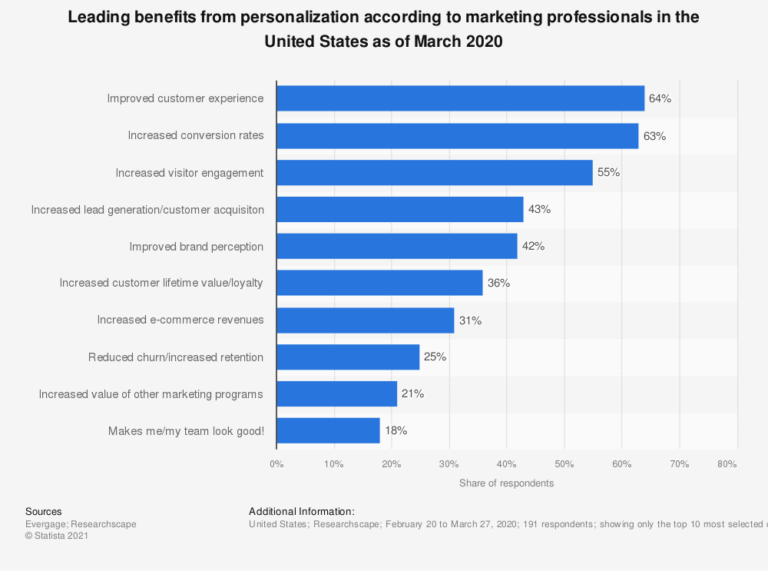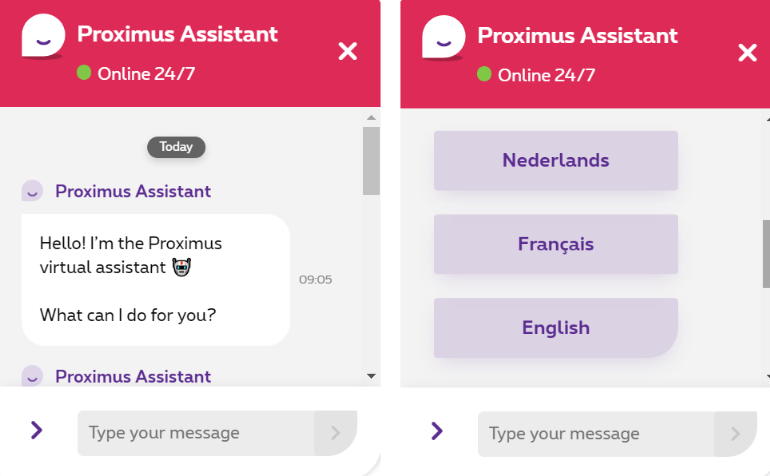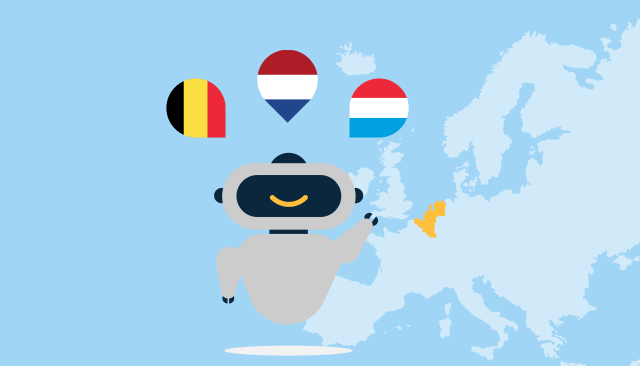In diverse linguistic settings, such as the Benelux region, companies can greatly benefit from multilingual chatbots. Here’s why!
“Bonjour!”; “Guten Tag!”; “goededag”: Hearing French, German, and Dutch / Flemish is very common in the multilingual Benelux region. And with English being the lingua franca, it’s one of the more diverse linguistic regions in Europe. Of course, this affects the communication between clients and companies as well.
Customers expect companies to interact with them in their preferred language. For companies, this means that everything, from their website to their customer support, should also be multilingual. In theory. Because in practice, it requires more resources to hire employees that are fluent in four languages, and in the current labor market, it’s also not that easy to find them. If your company is operating globally, the challenge gets even bigger.
Luckily, there's an excellent solution for this: multilingual chatbots!
What's a multilingual chatbot?
As a type of conversational technology, chatbots are designed to understand human language and respond to it. This could be either by text or voice. More advanced chatbots use natural language processing (a sub-field of AI) and conversation design to be able to communicate with humans in a more natural way.
While natural language processing helps the bot to better understand what humans want, conversation design makes sure that the flow of conversation is smooth and sounds natural.
Multilingual chatbots are therefore chatbots that can interact with customers in more than one language, says Joachim Jonkers, chatbot expert and Conversational AI Product Leader at Sinch.
This is important for companies that are active in a country that has multiple languages, like Belgium, for example, or for global companies that are active in multiple countries.
Joachim Jonkers | Conversational AI Product Leader at Sinch
The big advantage of multilingual chatbots is that for them — unlike for humans — with the right infrastructure, speaking one language or speaking 100 doesn’t make a big difference.
If you’re a company that’s already set up to support multiple languages, this will feel very natural. For companies that are just getting started with multilingual support, this could be a great first step, because it’s so easy to use.
Joachim Jonkers | Conversational AI Product Leader at Sinch
For companies that work in a multilingual setting, such as the Benelux region (but also India or the US, for example), chatbots that can interact in more than one language offer numerous advantages.
Why should I use multilingual chatbots for my business?
Multilingual chatbots offer your business many benefits, especially in a diverse setting, such as the Benelux countries.
More personalized customer interaction
Multilingual chatbots can interact with your customers in their preferred language. This could be French, German, Dutch / Flemish or English, but also Arabic, Chinese, Bengali, or Indonesian! Integrating a multilingual chatbot allows you to offer your customers a more personalized interaction.
Deliver a better customer experience
More personalized customer interactions also lead to a better customer experience. Surveys show that personalized customer service leads to an improved customer experience, but also to better conversions. All the more reason to invest in multilingual chatbots!

Grow your customer base
Multilingual chatbots will not only improve the customer experience, but they will also help you grow your customer base. Being able to reach out to customers in multiple languages is a straight-forward path to gaining new customers for your business.
Stand out from your competitors
In a difficult economic climate, and in times when companies face not only regional, but global competition, being able to communicate with people in many different markets is a huge competitive advantage and will make your company stand out from your competitors!
Spending less for more
At the same time, multilingual chatbots can add all these advantages, while being cost-efficient. In fact, chatbots can reduce customer service costs by up to 30%!
This means that automating conversations will save you time and money, and they'll also reduce the workload for your employees — all while offering your customers a better experience. In the end, you're spending less and getting more out of it.
Three Benelux companies that are using multilingual chatbots successfully
Proximus: automating customer service in multilingual setting
Proximus is one of Belgium’s largest telecommunication companies. Naturally, Proximus receives a lot of customer queries. The queries either come from users curious about Proximus’ services and phone plans, but also from existing customers who are, for example, in need of technical support.
Being a Belgian company, these questions also come in multiple languages. Handling the large number of inquiries in several languages was becoming increasingly hard to handle for the customer support team.
As a solution, with the help of Sinch Chatlayer, Proximus introduced different chatbots, including a technical support chatbot and a customer service bot, both on the website and on the Facebook Messenger. And the best part is: it can help customers in multiple languages!

With the help of these multilingual chatbots, Proximus has seen a 120 percent increase in web shop orders and was able to save 10 minutes per customer interaction.
Foyer: handling requests in 125 languages
Foyer is a world-leading insurance and wealth management company. With many requests coming in 24/7 and in different languages, Foyer needed an automated solution to help their customers.
With Sinch Chatlayer’s multilingual AI bot, Foyer was able to answer 80% of incoming customer requests successfully, in 125 different languages.
"Thanks to the growing reputation of Sinch Chatlayer in linguistic design, in-depth knowledge of language issues specific to the Benelux markets, and specialized development in conversational AI technology, the partnership was a match made in chatbot heaven."
Manuel Kauffmann | IT Correspondent at Foyer
Belfius: “myBo” chatbot assists customers in multiple languages
As one of Belgium’s largest banks, Belfius serves one out of three Belgian citizens. That means: the customer service team has to be able to interact with customers in multiple languages. However, it’s also a time-consuming process, as the bank’s mobile app Is used by more than 1.4 million customers, and it can be time-consuming to handle insurance claims.
That’s why Belfius decided to introduce a multilingual chatbot with the help of Chatlayer by Sinch to help them process the insurance claims of their customers faster. “myBo” is able to assist customers in French, Dutch / Flemish, and English, and has been an immense help for the customer service team.
As a result, customers were now able to receive help 24/7 in their preferred language.
Thanks to myBo, Belfius Insurance noted an 87.5% increase in conversions, when comparing the filed claims using myBo to the traditional insurance claim forms.
Get in touch, and find out how you can also improve your customer communication with a multilingual chatbot!





